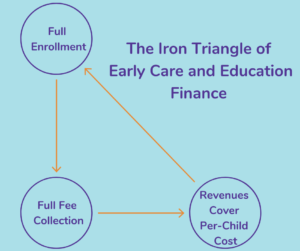If quality child care costs more than most families can afford, why is the child care market not financially stable?

When developing a budget or business plan, a child care center must consider the iron triangle: full enrollment, revenue that covers per-child expenses and on-time collection of fees. This blog explores the model developed by Louise Stoney (Alliance for Early Childhood Finance and Opportunities Exchange) and Libbie Poppick (Opportunities Exchange).
Full enrollment
Most businesses have a break-even point that tells them the level of revenue or sales needed to cover expenses. Child care centers aren’t quite as simple. The majority of revenue comes from tuition so an accurate enrollment estimate is imperative for budgeting. Since enrollment fluctuates, centers should have a goal of maintaining near full enrollment but may base their budgeting on 85% enrollment. In Arkansas, the teacher/student ratio for an infant classroom is one teacher for every five children, so a class size needs to be as close as possible to that to maximize tuition or revenue.
Revenues cover per-child cost
Beyond full enrollment, a center must make sure revenue covers the per-child cost of quality care. For many families, high quality child care is more than they can afford.The biggest price drivers for high-quality care are child-to-staff ratios, staff salaries and benefits. Other costs include rent, furnishings, food and educational materials. Eighty-five to ninety percent of the child care market is made up of small businesses and nonprofits, which are primarily funded by families’ tuition (57 percent) and government contributions (40 percent).
Full fee collection
As a result of the high price of quality care and working to maintain full enrollment, most centers operate with razor thin margins. This makes full fee collection imperative — late or missed payments can create instability for a center.
A high-quality child care center strives to provide a nurturing and stimulating environment for its children, but in order to remain financially stable it must maintain the delicate balance of the “iron triangle.” It is critical for the growth and stability of our economy that we support quality child care because parents are more likely to be productive at work if they’re confident their children are in a safe and nurturing environment. Excel by Eight is working to improve the access to quality infant and toddler childcare in Arkansas. To learn more about our efforts, review our policy agenda and sign up for our newsletter.
